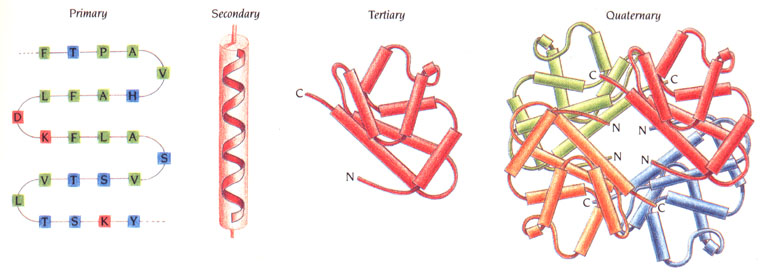ProteinsThe word 'protein' comes from Greek 'prota', meaning 'of primary importance'. Back in 1838, Jons Jakob Berzelius introduced the word 'protein' to name large organic compounds featuring almost equivalent empirical formulas. This word was used as the studied organic compounds were considered primitive while extremely important for animal nutrition. Another significant step of the protein study was performed in 1926 by James B. Sumner, who showed that enzymes can be isolated and crystallized. Later, in 1955, Frederick Sanger determined the entire amino acid sequence of the first protein, known today as insulin. This was the first proof of the fact that all proteins have specific structure. Three years later, the 3-dimensional structures of haemoglobin and myoglobin were determined by Max Perutz and Sir John Cowdery Kendrew, respectively, through X-ray diffraction analysis. The terms 'protein', 'polypeptide', and 'peptide' are a bit ambiguous and are able to overlap in meaning. Protein is usually used to specify the entire biological molecule in a stable conformation, while peptide refers to short amino acid oligomers, in most cases lacking a stable 3-dimensional structure. Nevertheless, the difference between them isn't well defined and generally lies near 20-30 residues. Polypeptide can be envisaged as any single linear chain of amino acids, generally regardless of length. However, it usually implies an absence of a defined conformation. Actually, proteins are the basic building blocks of all life. For instance, the human body contains around 100,000 various proteins, and every cell in our body contains protein, which is a major part of our skin, organs, muscles, and glands. It can also be found in almost all body fluids. Humans need protein in their diet in order to help the body repair cells and produce new ones. In addition, protein is also important for growth and development of humans during childhood, adolescence, and pregnancy. Proteins can be of different length and structure and consist of polymers of twenty different amino acids that fold upon themselves in order to create a shape which is characteristic for each protein. The function and properties of various proteins are defined by the sequence of twenty different amino acids. The sequence in question depends on the genetic data, which is contained in the DNA. A lot of proteins are encoded on each piece of DNA, and that's why it is vital for biologists to find out where the protein code begins and ends. Nevertheless, this is quite complicated as the human genome features more DNA than is needed to encode proteins. As it has already been said, the structure of a protein is created by the folding of a peptide chain back on itself, and sometimes the association of multiple peptide chains. Such folding happens because of the rotation of bonds within the amino acids and bonds joining various amino acids. In their attempts to understand the structural complexities of proteins, scientists decided to divide them by the structure, which can be primary (only a sequence of amino acids in the protein); secondary (like helical or sheet-like structures and beta sheets); tertiary (comprised of super secondary structures); and quarternary (multiply-folded polypeptide chains). Finally, the development of a tertiary structure turns a linear amino acid sequence into a 3-dimensional structure. Most part of proteins will lose their structure if they are put in unsuitable chemical conditions, like high or low pH, high salt concentrations, or hydrophobic environment, as well as physical conditions like high temperature or pressure. Such process can be called denaturation. Those proteins that have been denatured have no defined structure and, particularly if concentrated, in most cases aggregate into insoluble masses. Of course, protein denaturation is an outstanding event: for example, a boiled egg will become solid only because of denaturation and subsequent aggregation of its proteins. In some cases denatured proteins are able to refold if put again in the correct environment, but in some cases the process is irreversible (particularly after aggregation, which has a good example of the boiled egg again). The proteins are also responsible for susceptibility or resistance to a pathogen or parasite. |
||
|
||
